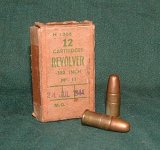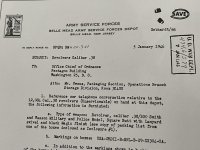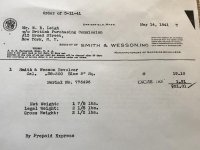You are using an out of date browser. It may not display this or other websites correctly.
You should upgrade or use an alternative browser.
You should upgrade or use an alternative browser.
38-200 Bullets
- Thread starter HRRutz
- Start date
Register to hide this ad
Matt’s Bullets.
Absalom
SWCA Member, Absent Comrade
Yeah, that's the one source I've seen. I'm surprised there aren't more, considering how this was once such a popular caliber.
Well, such a widespread caliber.
Well, .38-200 isn’t really a caliber, just a 200gr bullet for the .38 S&W. That weight has no particular virtues. I would think you can find bullets and molds for other bullet types in the caliber.
keithhagan
Member
- Joined
- Dec 23, 2018
- Messages
- 221
- Reaction score
- 129
Try 9mm makarov bullets. Won't be 200gr, but will let you load relatively cheaply with more available components.
May want to run through a sizer.
9x18 Makarov (.365) - Handgun Bullets - Metallic Reloading - Graf & Sons
May want to run through a sizer.
9x18 Makarov (.365) - Handgun Bullets - Metallic Reloading - Graf & Sons
I have good luck with hollow base wadcutters or cupped base 158 SWC. Otherwise I use Matt's bullets.
Skyhunter
Member
MAGNUS makes a good 200 gr. RNFB. I use them for some .38 loads and as subsonic plinkers in my '94 Marlin. I'm on my second or third box of 500, so yeah, I've been pleased with them.
WYT-P
Skyhunter
WYT-P
Skyhunter
gwpercle
Member
If you would like a bullet mould ... right now NOE has one double cavity #360 - 197 - RN aluminum mould in stock ... this is the classic 200 grain (197 gr. cast in Wheel Weights) Round Nose bullet with two lube grooves and a crimping groove . You can look at drawings at
www.noebulletmoulds.com go to shop and click on Our Products
and click on .358" all the bullets will show when you scroll it goes from lightest to heaviest . Nice moulds and Al Nelson is a good guy .
There is only one in stock ... you may want to get it ...now !
Gary
www.noebulletmoulds.com go to shop and click on Our Products
and click on .358" all the bullets will show when you scroll it goes from lightest to heaviest . Nice moulds and Al Nelson is a good guy .
There is only one in stock ... you may want to get it ...now !
Gary
DWalt
Member
You will likely find that .357-.358 lead bullets used for .38 Special will work just fine. Please note that the SAAMI standards for the .38 S&W specify a minimum bullet diameter of 0.355". Some reloading manuals recommend using .357 bullets. I have used the smaller bullets for many years with complete satisfaction. A few thousandths in diameter has no significant effect. My favorite bullet for the .38 S&W is a 125 grain .358 cast bullet. Some recommend using the 148 grain .38 Special hollow base wadcutter for the .38 S&W.
Should you wish to buy .360 lead bullets, Missouri Bullet Co. has them, at least in 145 grain. The only reason I can think of for using 200 grain bullets is if they might shoot closer to the aiming point.
If you own a more modern solid frame revolver (not a top break), it is simple to reload the .38 S&W to achieve .38 Special ballistics.
Should you wish to buy .360 lead bullets, Missouri Bullet Co. has them, at least in 145 grain. The only reason I can think of for using 200 grain bullets is if they might shoot closer to the aiming point.
If you own a more modern solid frame revolver (not a top break), it is simple to reload the .38 S&W to achieve .38 Special ballistics.
Last edited:
It's a Victory, so it's plenty beefy for any loading I could put in the case. I'm just trying to feed it the WWII food it's craving.
I tried it with some modern 38SW and the point of impact was way off. The muzzle energy is so low with Hodgdon's book load that I don't want to play the aim-by-powder-charge game with it. I'd rather find the right bullet and run a full charge.
I tried it with some modern 38SW and the point of impact was way off. The muzzle energy is so low with Hodgdon's book load that I don't want to play the aim-by-powder-charge game with it. I'd rather find the right bullet and run a full charge.
Absalom
SWCA Member, Absent Comrade
It's a Victory, so it's plenty beefy for any loading I could put in the case. I'm just trying to feed it the WWII food it's craving….
The irony is of course that by the time S&W began manufacturing the British Service model in 1940, referencing it as .38/200, and Colt in 1941 even put that designation on their OP barrels, it had been overtaken by events.
According to Stamps/Skennerton, the standard reference on the Enfield for which the cartridge existed, it was the Tank Corps that first pointed out the susceptibility of the 200gr soft lead bullet to deformation and instability, causing possible Hague Convention issues.
In 1937 the .380/200 Mk I cartridge was replaced in British service by the .380 Mk IIz, which had a 178gr jacketed bullet.
Attachments
Last edited:
I have some Laser Cast Oregon Trails bullets for the .38 spl. Will these be o.k. for reloading for the 38-200 Victory revolver?
In 1937 the .380/200 Mk I cartridge was replaced in British service by the .380 Mk IIz, which had a 178gr jacketed bullet.
That's why I asked whether anyone knew of a source. But I'm happy enough with lead if that's all that's available.
The irony is of course that by the time S&W began manufacturing the British Service model in 1940, referencing it as .38/200, and Colt in 1941 even put that designation on their OP barrels, it had been overtaken by events.
According to Stamps/Skennerton, the standard reference on the Enfield for which the cartridge existed, it was the Tank Corps that first pointed out the susceptibility of the 200gr soft lead bullet to deformation and instability, causing possible Hague Convention issues.
In 1937 the .380/200 Mk I cartridge was replaced in British service by the .380 Mk IIz, which had a 178gr jacketed bullet.

It is still a bit of a mystery as to why the British contract for 18,250 Colt OP's were marked.38/200 when this Mark 1 had already been declared obsolescent before the war kicked off in September 1939 and the 178 grain Mk11 round was standard issue. I have never seen any documentation that casts any light on the matter.
Regards
Alan
Absalom
SWCA Member, Absent Comrade
It is still a bit of a mystery as to why the British contract for 18,250 Colt OP's were marked.38/200 when this Mark 1 had already been declared obsolescent before the war kicked off in September 1939 and the 178 grain Mk11 round was standard issue. I have never seen any documentation that casts any light on the matter.
Regards
Alan
I don‘t have any specific documentation from Colt either, but I do believe that the .38-200 label was the accepted name for the British Service version of the .38 S&W, at least in the US, regardless of the actual bullet.
I don‘t know how the BPC referenced the caliber, but it shows up as .38-200 in the receipt by S&W to the BPC from 1941. The document is from the SWHF files.
Charles Pate also shows an Army document where it is still given as .38/200 in 1946.
Attachments
W. E. Leigh, has his position shown on British Purchasing Commission letters as, Purchasing Agent for Munitions. No doubt small arms was just one of his portfolios.
The above delivery is just one pistol which may have been a sample. A similar order was placed in 1940 for one revolver for display in a showroom that the BPC had at 15 Broad street, New York.
Regards
Alan
The above delivery is just one pistol which may have been a sample. A similar order was placed in 1940 for one revolver for display in a showroom that the BPC had at 15 Broad street, New York.
Regards
Alan
I have to disagree with the accuracy of 38 Special bullets in a 38 S&W revolver. First, the bore of British 38 S&W is around .361" and the diameter of a 38 Special bullet is .357". I find most references indicate rifling depth in revolvers is from .002" to .005" so a .357" bullet shot in a .002" depth rifled bore theoretically might not touch the rifling. I have shot many 357 bullets in 38 S&W guns over the years and found it to be totally or nearly unacceptable in top-breaks and solid frame revolvers. For the best accuracy, stick with the right caliber bullet for each and every gun you own.
As for bullet weight, the easiest 38 S&W bullet to find is the 145 grain, .361" round nose lead and it shoots great out of the WWII British 38s. I get mine from Missouri Bullets for around $0.08 a bullet. The 200 grain British bullet was designed as a small caliber man-stopper and I assume you are not loading for that purpose. It seemed that the British put a lot of faith in heavy slugs at close range, including their heavy 265 grain bullets in the .455 revolvers.
http://smith-wessonforum.com/s-w-sm...different-caliber-handguns.html#post139240813
As for bullet weight, the easiest 38 S&W bullet to find is the 145 grain, .361" round nose lead and it shoots great out of the WWII British 38s. I get mine from Missouri Bullets for around $0.08 a bullet. The 200 grain British bullet was designed as a small caliber man-stopper and I assume you are not loading for that purpose. It seemed that the British put a lot of faith in heavy slugs at close range, including their heavy 265 grain bullets in the .455 revolvers.
http://smith-wessonforum.com/s-w-sm...different-caliber-handguns.html#post139240813
Last edited:
Luckily I live close to a chap who sells lead bullets and he ran off a large batch of 200 grain 0.361 diameter bullets that I have used for years in S&W and Webley Mk IVs. Quite accurate at 10 metres. Dave_n
DWalt
Member
The BSR bore diameter for the .38 S&W(.38/200) cartridge is 0.350 - 0.3512 with a land width of 0.1059. Assuming a typical groove depth of around 0.004", the groove diameter would be about .358-.359. I have found that any lead .358" bullet is perfectly satisfactory in any of my .38 S&W revolvers. Were that not the case, SAAMI would have specified a larger minimum bullet diameter than 0.355". The corresponding bore dimensions for .38 Special is 0.346 - 0.3472 with a land width of 0.1034.
Last edited:
Similar threads
- Replies
- 10
- Views
- 799
- Replies
- 14
- Views
- 652
- Replies
- 15
- Views
- 554
- Replies
- 9
- Views
- 683



